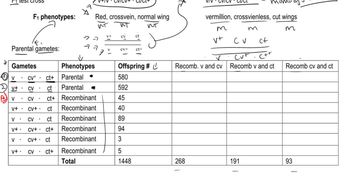Pigment in mouse fur is only produced when the C allele is present. Individuals of the cc genotype are white. If color is present, it may be determined by the A, a alleles. AA or Aa results in agouti color, while aa results in black coats. What F₁ and F₂ genotypic and phenotypic ratios are obtained from a cross between AACC and aacc mice?
Table of contents
- 1. Introduction to Genetics51m
- 2. Mendel's Laws of Inheritance3h 37m
- 3. Extensions to Mendelian Inheritance2h 41m
- 4. Genetic Mapping and Linkage2h 28m
- 5. Genetics of Bacteria and Viruses1h 21m
- 6. Chromosomal Variation1h 48m
- 7. DNA and Chromosome Structure56m
- 8. DNA Replication1h 10m
- 9. Mitosis and Meiosis1h 34m
- 10. Transcription1h 0m
- 11. Translation58m
- 12. Gene Regulation in Prokaryotes1h 19m
- 13. Gene Regulation in Eukaryotes44m
- 14. Genetic Control of Development44m
- 15. Genomes and Genomics1h 50m
- 16. Transposable Elements47m
- 17. Mutation, Repair, and Recombination1h 6m
- 18. Molecular Genetic Tools19m
- 19. Cancer Genetics29m
- 20. Quantitative Genetics1h 26m
- 21. Population Genetics50m
- 22. Evolutionary Genetics29m
2. Mendel's Laws of Inheritance
Dihybrid Cross
Problem 17c
Textbook Question
In rats, the following genotypes of two independently assorting autosomal genes determine coat color:

A third gene pair on a separate autosome determines whether or not any color will be produced. The CC and Cc genotypes allow color according to the expression of the A and B alleles. However, the cc genotype results in albino rats regardless of the A and B alleles present. Determine the F₁ phenotypic ratio of the following crosses:
AaBbCc×AaBbcc
 Verified step by step guidance
Verified step by step guidance1
Identify the genotypes and phenotypes involved: The first two genes (A and B) determine coat color with the following phenotypes: A-B- (gray), A-bb (yellow), aaB- (black), and aabb (cream). The third gene (C) controls whether color is expressed: CC or Cc allows color, while cc results in albino regardless of A and B.
Determine the possible gametes from each parent: For AaBbCc, the gametes are ABC, ABc, AbC, Abc, aBC, aBc, abC, and abc. For AaBbcc, since cc is homozygous recessive, the gametes are limited to Abc, aBc, abC, and abc (but since cc is fixed, only c alleles are passed).
Set up a Punnett square for the C gene first: Cross Cc (from AaBbCc) with cc (from AaBbcc). The offspring genotypes for C will be 50% Cc (color expressed) and 50% cc (albino).
For the offspring with Cc genotype, determine the phenotypic ratios based on A and B gene combinations from AaBb × AaBb cross. Use the dihybrid cross ratios for A and B genes to find proportions of gray, yellow, black, and cream.
Combine the results: Multiply the proportion of colored offspring (Cc) by the phenotypic ratios from the A and B genes, and add the proportion of albino offspring (cc), which will be 50%. This will give the overall F₁ phenotypic ratio.
 Verified video answer for a similar problem:
Verified video answer for a similar problem:This video solution was recommended by our tutors as helpful for the problem above
Video duration:
2mPlay a video:
Was this helpful?
Key Concepts
Here are the essential concepts you must grasp in order to answer the question correctly.
Independent Assortment of Genes
Independent assortment refers to the principle that genes located on different chromosomes segregate independently during gamete formation. This means the alleles of one gene pair segregate without affecting the segregation of another gene pair, allowing for the prediction of genotype and phenotype ratios using Punnett squares.
Recommended video:
Guided course

Gamete Genetics and Independent Assortment
Epistasis and Gene Interaction
Epistasis occurs when one gene masks or modifies the expression of another gene. In this case, the third gene (C locus) controls whether color is produced at all, overriding the effects of the A and B loci when homozygous recessive (cc), resulting in albino rats regardless of other alleles.
Recommended video:
Guided course

Interacting Genes Overview
Phenotypic Ratios in Dihybrid and Trihybrid Crosses
Phenotypic ratios describe the proportion of offspring showing particular traits from genetic crosses. When multiple genes interact, such as A, B, and C loci here, calculating phenotypic ratios requires considering both independent assortment and epistatic effects to predict the distribution of coat colors.
Recommended video:
Guided course

Trihybrid Cross
Related Videos
Related Practice
Textbook Question
723
views


